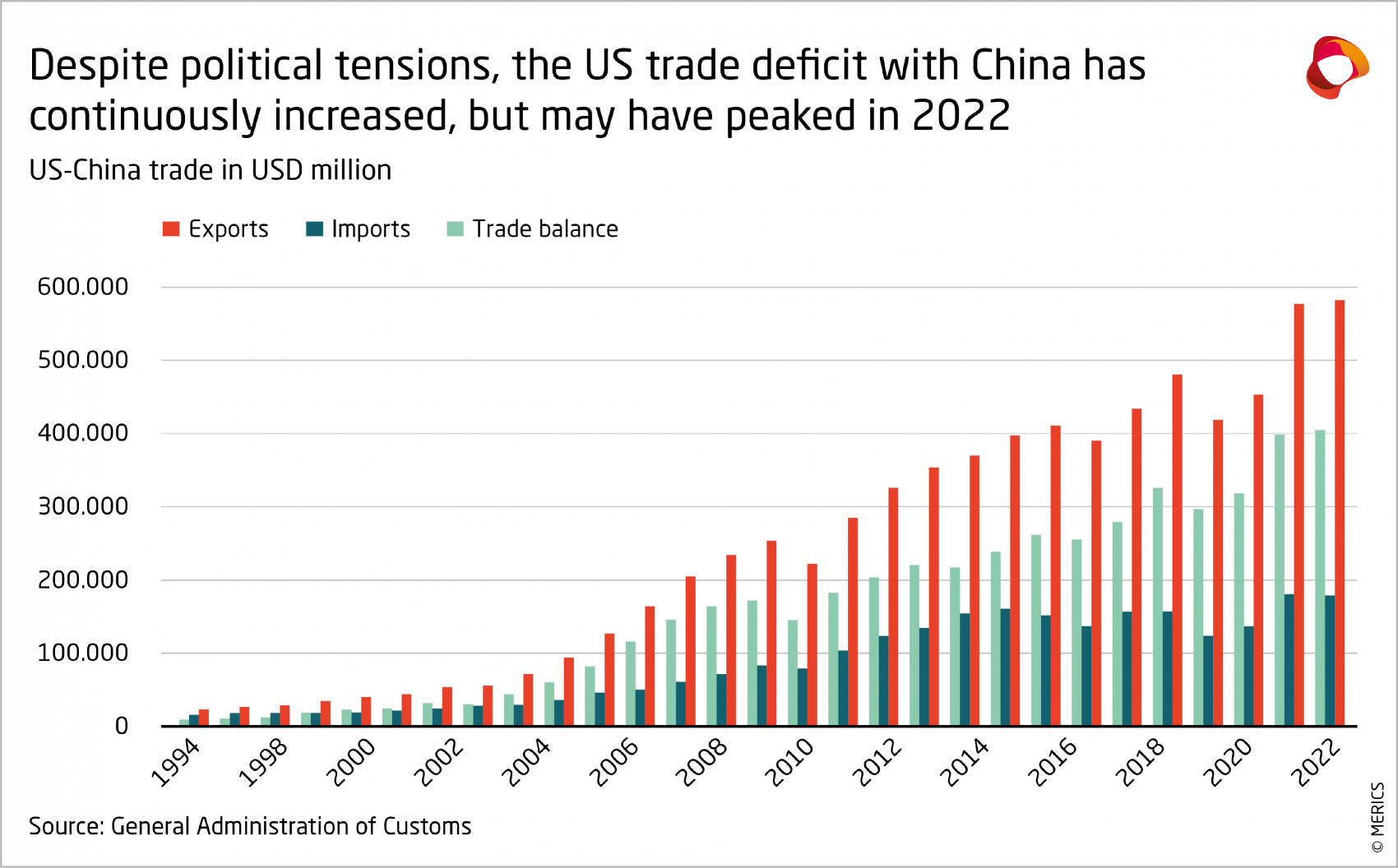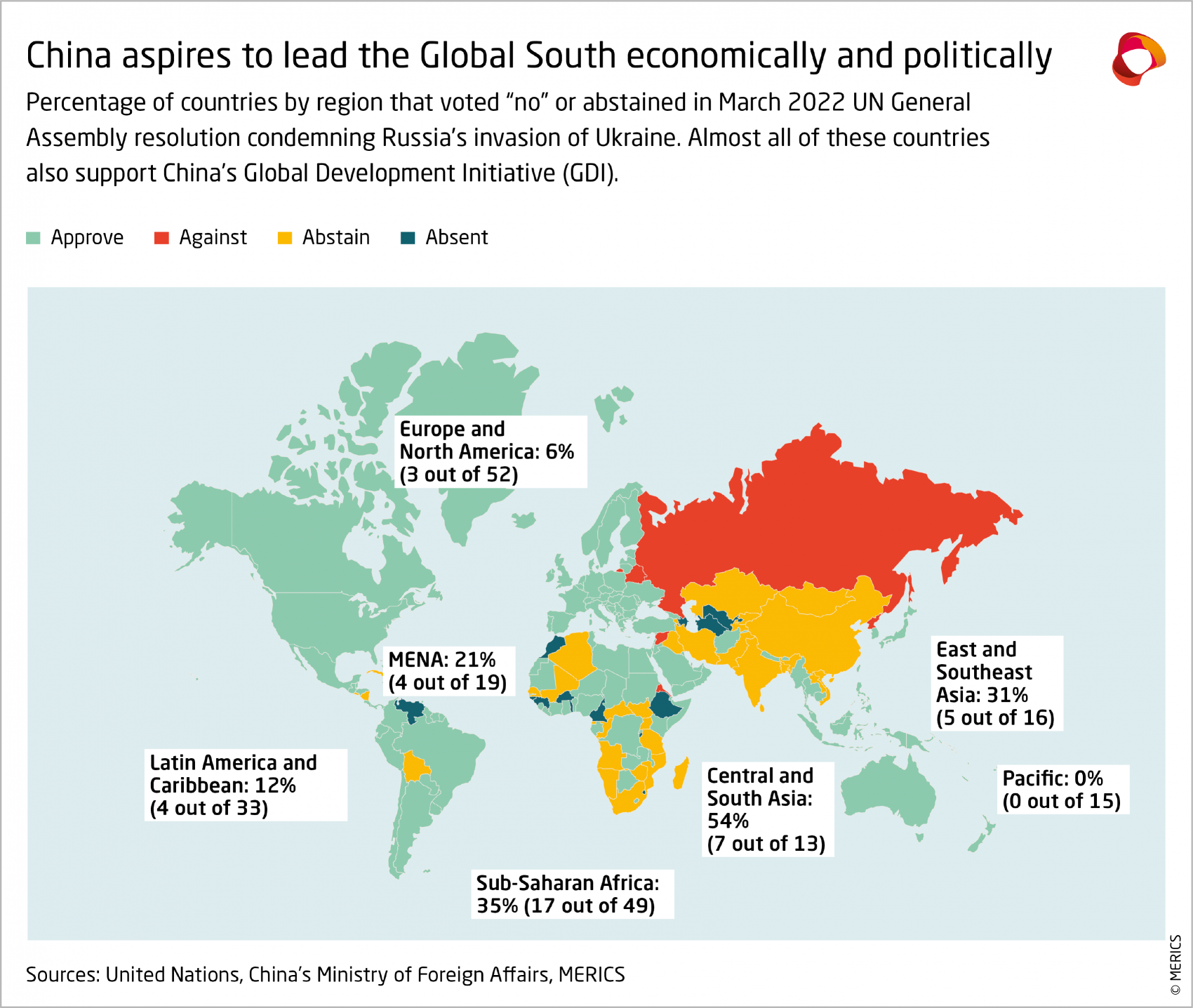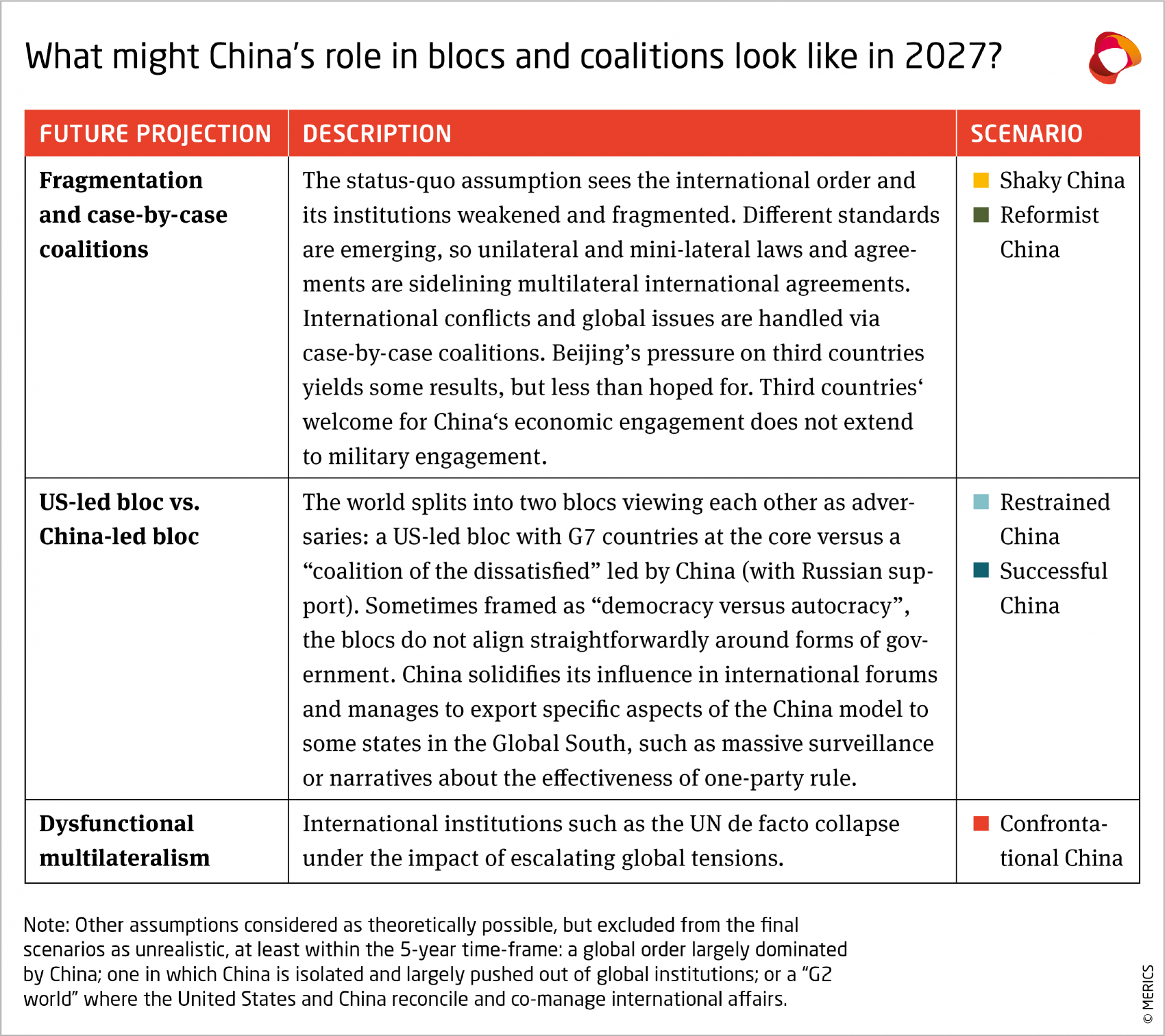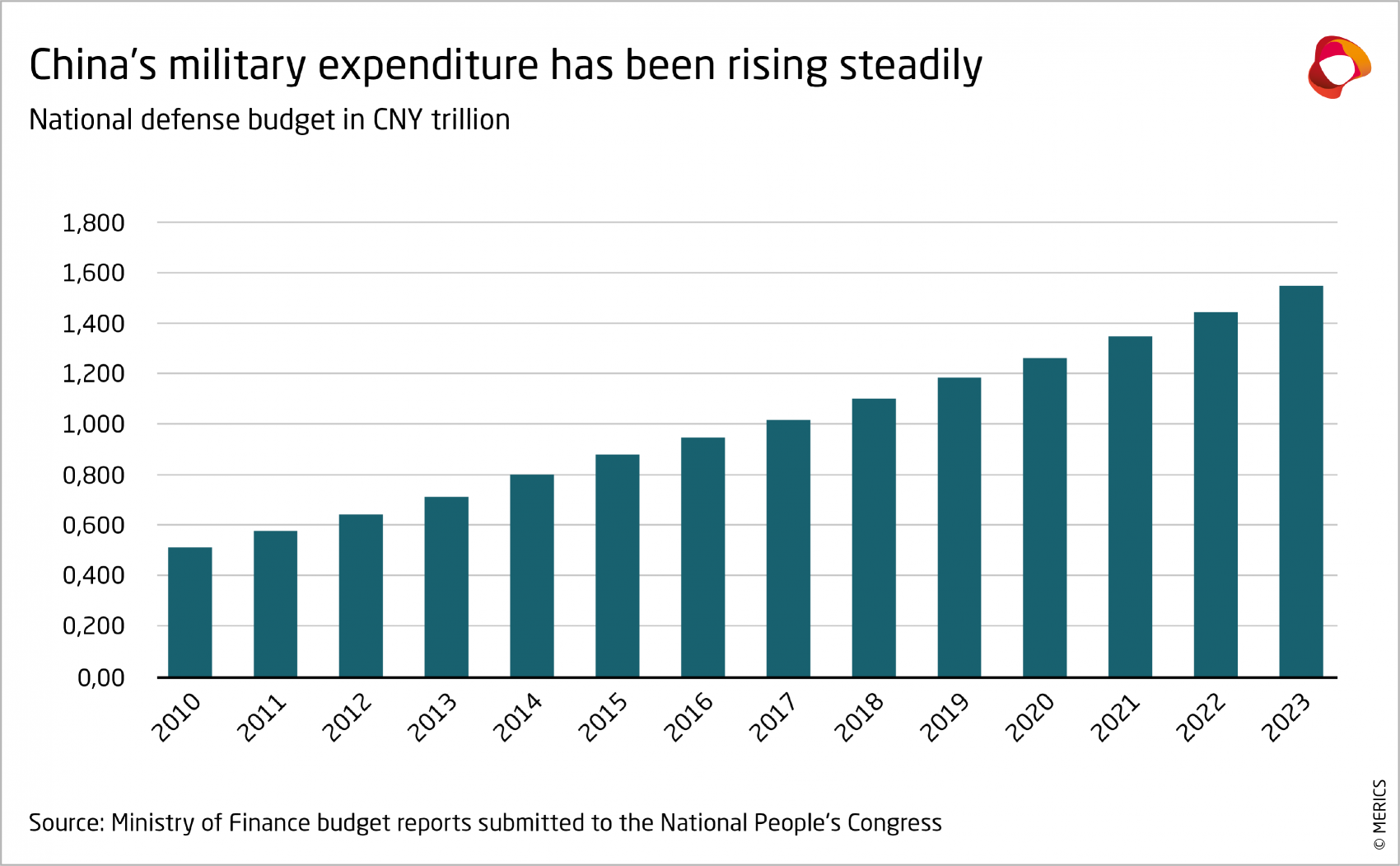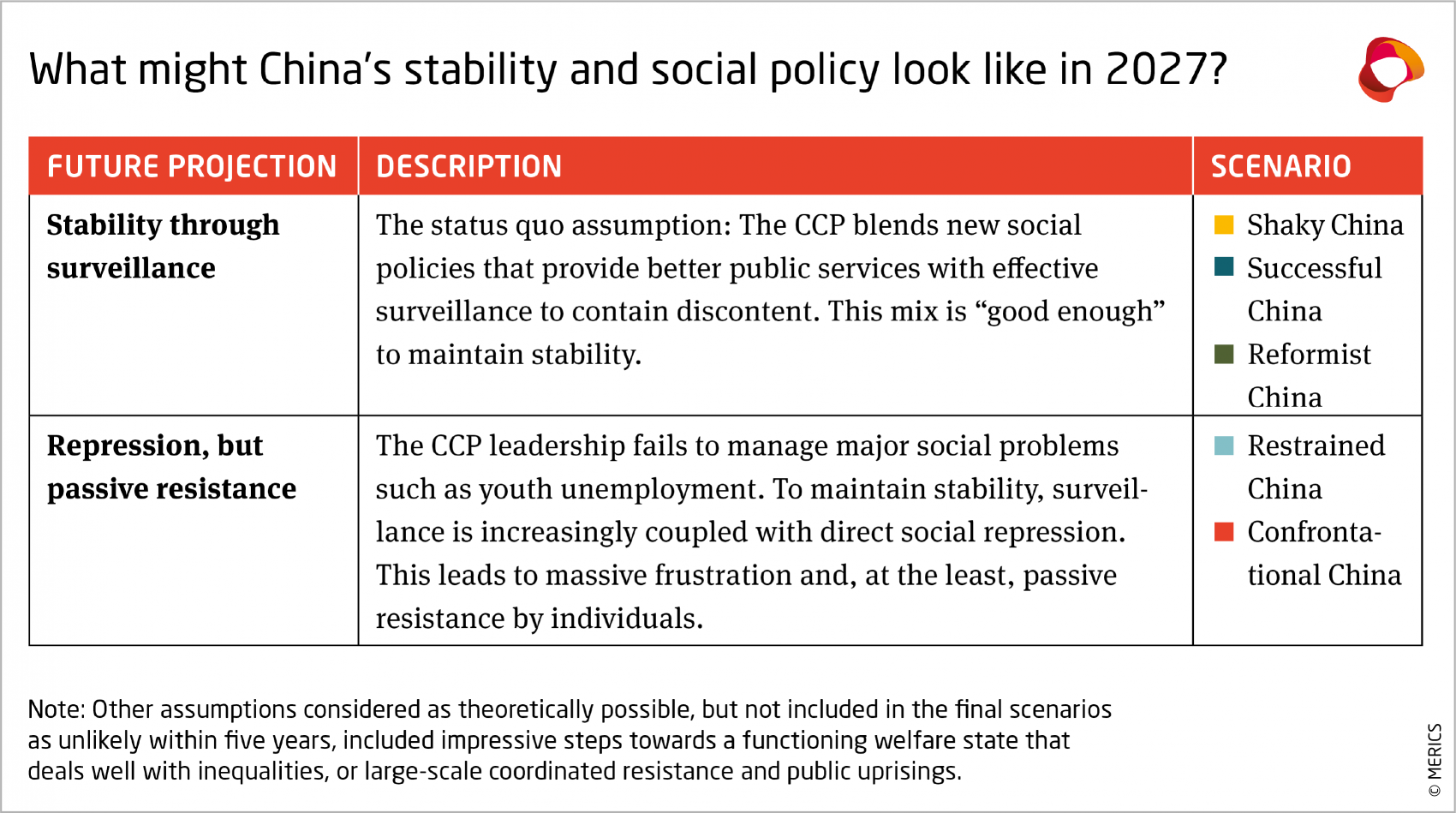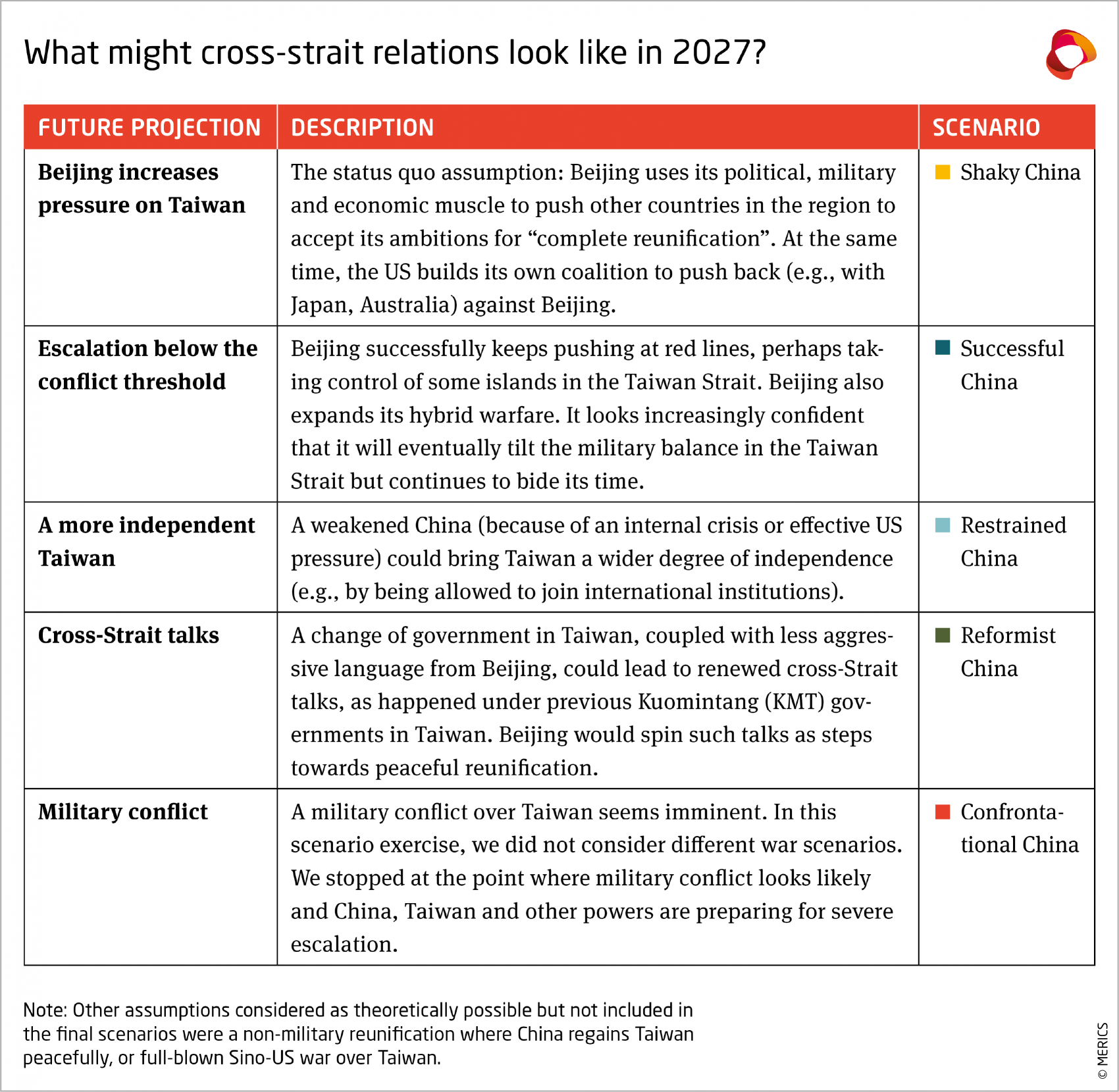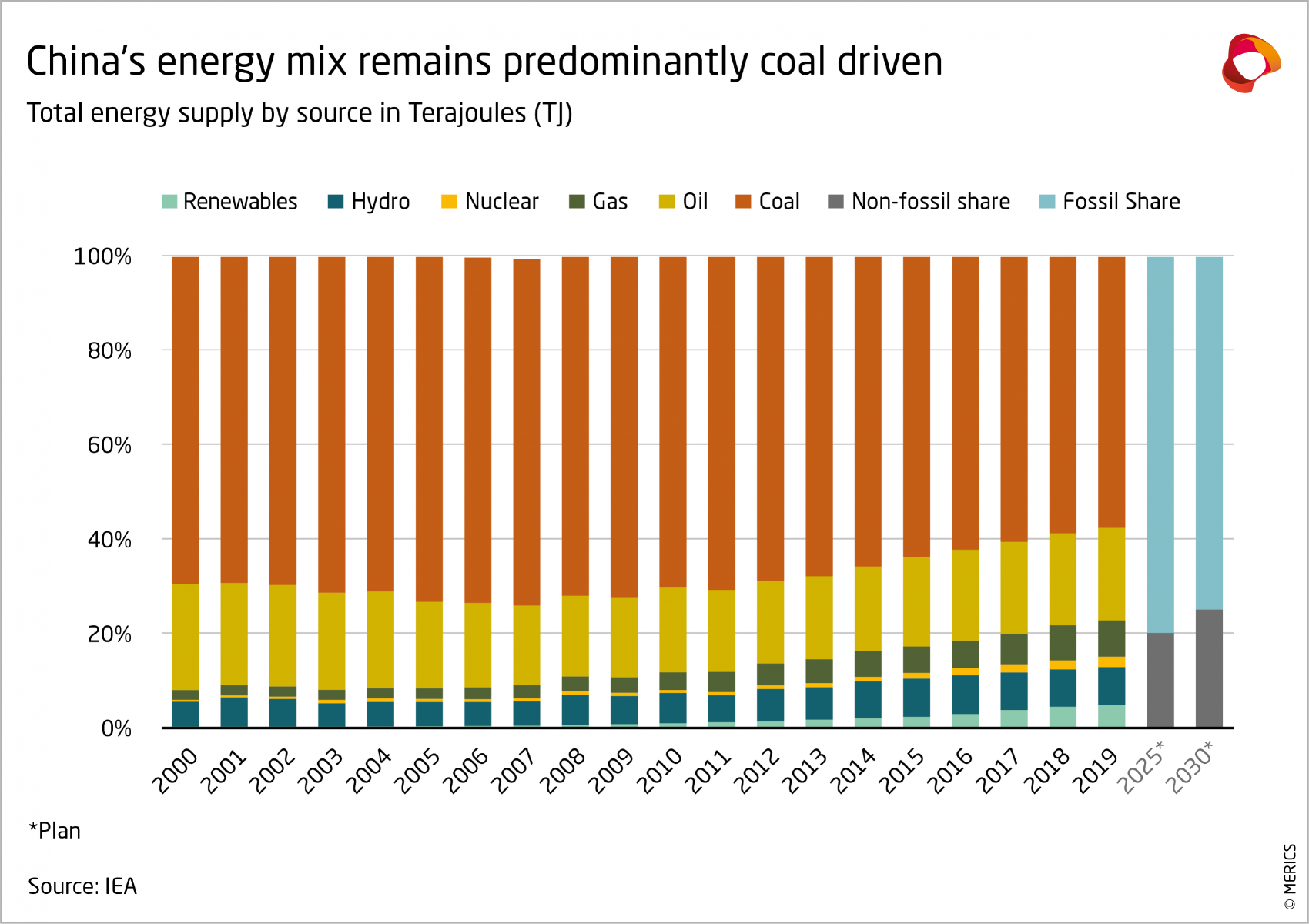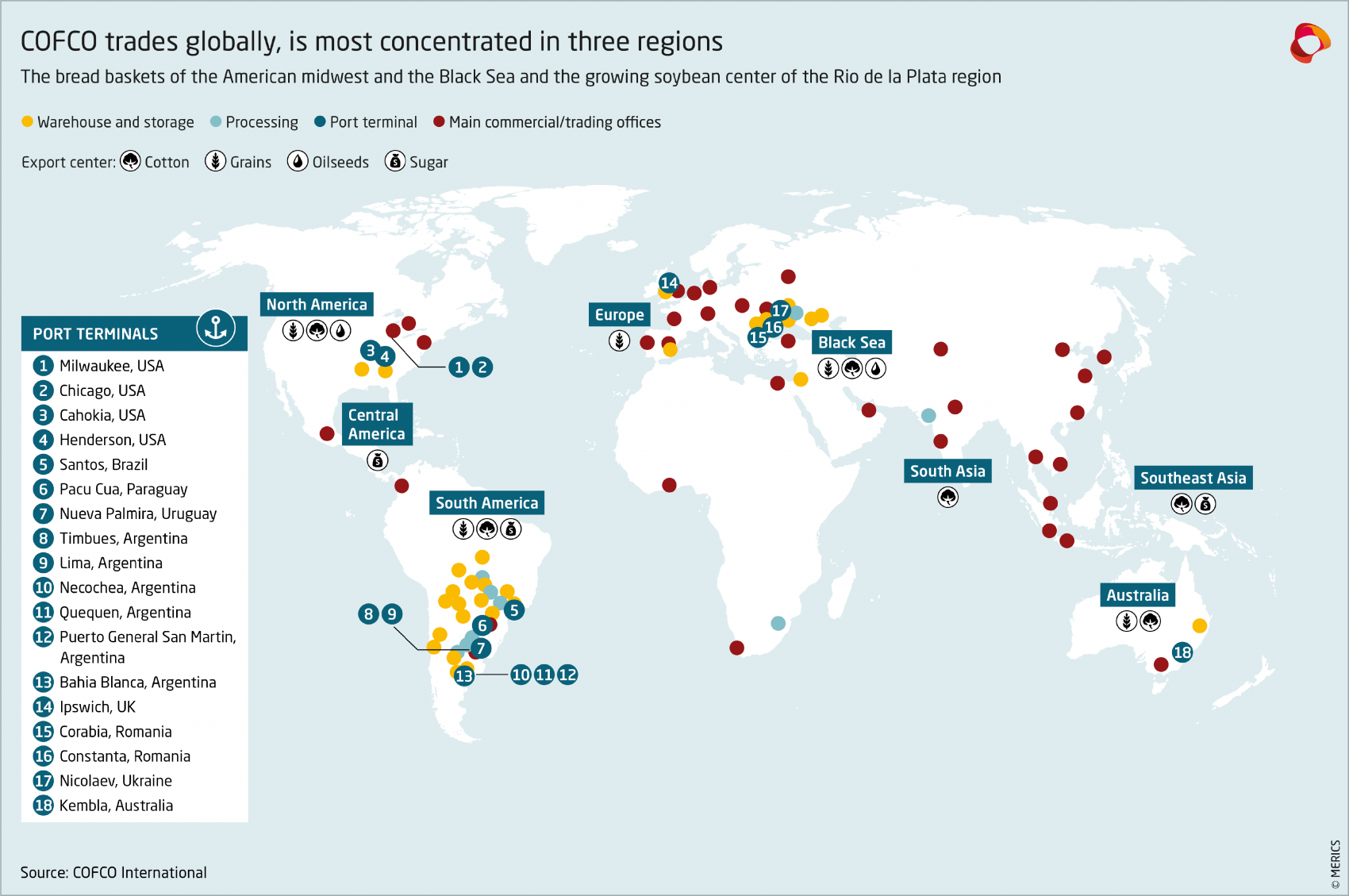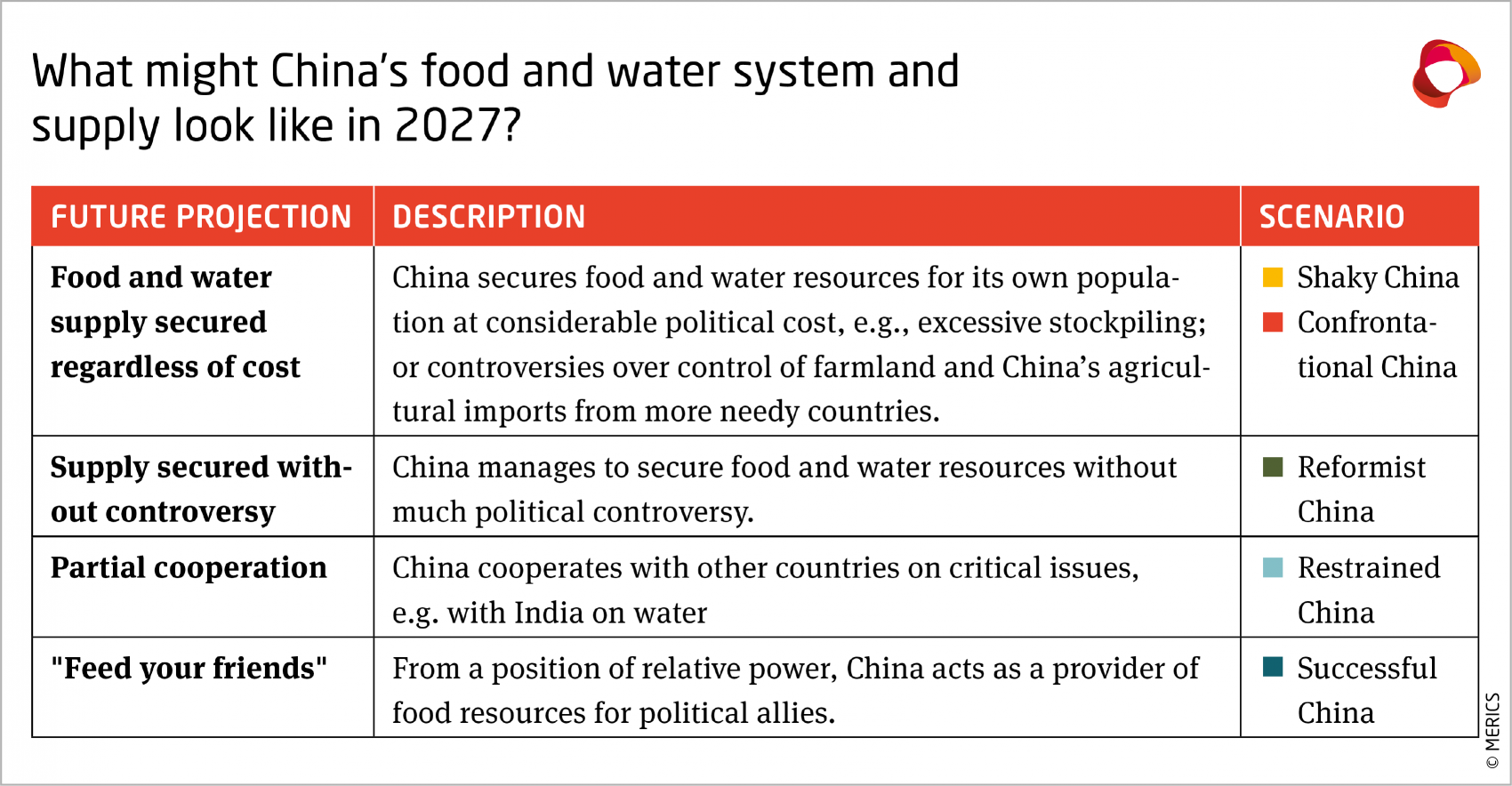

Political and social factors
You are reading the chapter on "Political and social factors" of the report "Shaky China - Five scenarios for Xi Jinping's third term". Click here to go back to the table of contents.
China-US relations
Status quo
China’s leadership considers itself in long-term strategic competition with the United States. The Chinese Communist Party (CCP) is convinced that any US administration will work to prevent China‘s rise, orchestrate an international alliance to curb its influence, discredit its political system and undermine stability.
The CCP leadership believes China’s political system (which it has baptized “whole-process people‘s democracy” to reject a binary choice between democracy and autocracy) will prove more effective than US democracy in the long run, and that the United States is a declining power. For now, China must live with US dominance, notably US military supremacy in the Asia Pacific and US economic and technical pre-eminence. Beijing aims to maintain stable, predictable relations with the United States. Meanwhile, it is trying to improve China’s resilience towards risks such as US efforts to block China from access to certain technologies or capital. Beijing is developing its own retaliatory toolkit against US sanctions or trade restrictions. Growing US-China tensions are generating mutual suspicion and hostility among ordinary citizens of both countries.
Drivers and dynamics
Beijing wants to decrease dependencies on the United States. Having seen the G7 apply sanctions on Russia for its attack on Ukraine, the CCP leadership wants to protect China against similar pressures. This is particularly true of the financial sector as well as the tech sector where Beijing has noted Russia’s isolation from the Swift banking transfers system and frozen foreign reserves.
US-China relations in the coming years are highly contingent on US politics. The relationship’s specifics will hinge upon who holds power in Washington, though there is a far stronger bipartisan consensus on strategic challenges vis à vis China than previously.
To counter US dominance, China aims to expand ties with the Global South; it will shape its own networks of partnerships and alliances, deploying the twin wrappers of Beijing’s Global Security Initiative and Global Development Initiative.
China’s role in blocs and coalitions
Status quo
Beijing assumes a leading or co-leading role in coalitions it has participated in forming, such as BRICS or the SCO, and is now pushing to expand those frameworks, especially in the Global South. In firmly-established bodies such as the UN, China exerts influence within the existing structures, aiming to shape them to suit its interests.
China is evolving alternative global governance structures as it upgrades its foreign policy paradigm. It is broadening out from the mainly economic focus typified by the Belt and Road Initiative (BRI) to promote security-related initiatives, like the Global Security Initiative, with supporting narratives that are anti-Western or anti-US. So far, this shift does not appear to be particularly successful. However, even if China is not yet able to shift geopolitical alignments across the Global South, it finds a receptive audience for its narratives.
Drivers and dynamics
China increasingly declares its ambition to lead in global governance issues and shows determination to shape a post-Western order. China aims to set new rules and shape existing norms to its advantage, but not necessarily to uproot the current order as a whole. The CCP leadership’s perceptions are shaped by their belief that China is rightfully re-emerging as a global power.
China’s hard power projection
Status quo
China’s foreign policy has become more assertive under Xi Jinping. The CCP believes it has a “period of strategic opportunity” to assume a more central role in international affairs. Yet, it also feels under siege by hostile Western forces. It sees attempts to contain its rise and threats to its core interests and national security in the US presence in the Indo-Pacific, transatlantic cooperation, the QUAD, AUKUS etc. The CCP has established a centralized and unified national security system built around the concept of “comprehensive national security” to tackle threats proactively and preemptively.
Drivers and dynamics
Gaining control over Taiwan and achieving military dominance in its neighborhood are the main objectives behind China’s massive military build-up. These goals require a military that can fight and win wars. China is seeking to project power to defend its interests beyond its neighborhood, e.g., by establishing military bases overseas, and increasing military-to-military cooperation with other countries. It is using platforms such as the Shanghai Cooperation Organization (SCO) or its Global Security Initiative to establish a security framework under Beijing‘s leadership and export its views on global security architecture. Russia ‘s war in Ukraine and the West’s response (sanctions, weapons supply to Ukraine) might further accelerate China‘s efforts to expand its hard power, especially its nuclear capabilities.
China’s political system
Status quo
When Xi Jinping clinched an unprecedented third term in power at the 20th Party Congress in October 2022, he and his allies gained ideological hegemony. No other factions are represented in the seven man top leadership group (the Politburo Standing Committee). Political activity is driven by ideology, by party loyalty and personal loyalties. In society at large, “rule by law” codifies party norms and integrates CCP rule into economic and institutional life. Xi appears to have a mandate and a power base to push through issues that were previously stalled due to politics. The risk of undivided power is that problematic norms and policies will not easily be challenged.
A key feature of Xi’s system of political management is centralized policy steering driven by incentives and supervision. It fosters campaign-style policy implementation (which can be erratic and inefficient), while diminishing local policy innovation and flexibility. Xi’s political victory in 2022 left open the possibility that he might rule for five more years after 2027.
Drivers and dynamics
As economic opportunities shrink and “patriotic duties” become more demanding, the foundations of decades-long “elite embeddedness” and loyalty to the system are shifting. Institutionalization of discipline and supervision measures ensure compliance with the center. As the party state expands its reach throughout society (the private sector, media, education, and civil society), there seems to be less room for alternative positions and course corrections.
China’s stability and social policy
Status quo
Government reforms blend better public services with even more intense surveillance to contain discontent. The pandemic has driven a major build-up of surveillance since 2020. However, Covid controls fomented significant social tensions over lost income and government overreach, expressed in a wave of protests in late 2022. Even after many Covid controls such as the “health code” were dropped, the government’s surveillance toolbox remains in place, ready for use when needed.
China struggles with a multitude of social problems that will continue to create tensions in coming years, including a rapidly aging society, income inequality, a slowing economy and massive youth unemployment. With its “Common Prosperity” concept, the CCP has signaled that it sees the challenges, but the current political agenda fails to address their root causes.
Drivers and dynamics
Slower economic growth means greater competition for resources between the social policy agenda and China’s security apparatus. Pressures on social systems (healthcare, social security) are rising fast, driven by demographic aging, which appears more rapid than expected. Inequality and socio-economic issues become more pronounced and create risks to the CCP’s performance-based legitimacy.
Cross-strait relations
Status quo
Cross-Strait tensions are at an at all-time high, as economic coercion and airspace incursions have become Beijing’s norm towards its “Taiwan problem”. Beijing is pushing to remove well-established constraints, such as the median line midway across the Strait. The PRC and Taiwan are de facto in a grey-zone conflict. PRC pressure on Taiwan is matched by growing support from the United States and its allies, who seek to uphold the status quo and push back China’s ambitions. Among Western politicians it is now normal to draw parallels between Russia’s war in Ukraine and the PRC’s threats to Taiwan as an attack on the global order that must be prevented.
In its August 2022 White Paper, called "The Taiwan Question and China's Reunification in the New Era”, the CPP reiterated peaceful reunification was the “first choice” but said it did not rule out using force. Beijing’s vision of how much autonomy Taiwan can expect post-reunification seems to be “Hong Kong 2.0”, meaning strong interference in Taiwan’s affairs rather than the version of “one country, two systems” that Hong Kong lived under until 2020.
Drivers and dynamics
China and the United States agree on the need for guardrails to keep tensions over Taiwan from spiraling out of control. However, tensions have escalated to the point that mistakes or accidents could have dramatic effects. Taiwan’s 2024 presidential elections seem certain to be accompanied by escalating friction, especially if voters choose the Democratic Progressive Party (DPP). Beijing calls the DPP secessionist and has refused to engage with its leaders. Taiwanese public opinion is increasingly critical towards Beijing, with a majority of over 60 percent surveyed identifying as solely Taiwanese, one third as Taiwanese Chinese and only a fraction as solely Chinese. For comparison, in 2007, identification as solely Taiwanese or as Taiwanese Chinese both stood at a level of around 44 percent.
Energy system and supply
Status quo
China, like the rest of the world, has deep concerns about energy security. Externally, the shock to global energy markets from Russia’s invasion of Ukraine continues to roil commodity markets. At home, the heat waves and droughts affecting China’s key water sources are taking out normally predictable hydropower sources, which account for roughly 16 percent of electricity production. China has resources to become self-sufficient in domestic thermal coal (still around 60 percent of electricity production), hydropower and renewable sources. But this will take years – especially in renewables - because capacities need to be increased. China is heavily reliant on imports of natural gas and crude oil – just under half of China’s 2021 natural gas was imported, while reliance on imported crude is even higher, at 72 percent of total consumption in 2021. Beijing has directed diplomatic efforts to establish energy ties with countries in the neighborhood, especially with Russia.
The 14th Five-Year Plan (2021-2025) lays out ambitious plans to drive decarbonization and indigenous tech innovation. China is striving for global leadership in green technologies and sustainable solutions, where it is building on past successes (e.g., in wind, solar and e-mobility).
Drivers and dynamics
In October 2021, Xi himself called for greater efforts to develop energy self-reliance, particularly in the oil and gas industry. As he put it, “The rice-bowl of energy must be in our own hands”. Since then, China’s three main oil and gas champions have drastically increased their capital investment in projects at home and abroad. China is seen as the main beneficiary of Russia’s declining exports to European countries and is pushing Moscow to build more pipelines to China.
Beijing has put a strategic bet on reaching a sustainable future through technological breakthroughs that are state-guided and funded. It seeks a green transformation at home and global tech leadership across the board, from renewables to environmental protection equipment. Cooperation on climate change and green technologies remains one of the few areas where partnerships between China and Western countries continue to thrive. Yet, competition for green tech and manufacturing processes is intense.
Food and water systems and supply
Status quo
Food and water security are politically sensitive issues in China. Beijing has a long-standing target of 95 percent national self-sufficiency in key grain production, and needs few imports for food security. Supply is achieved through a mix of protectionism and stabilizing factors. Resilience is maintained by massive state-run grain reserves. The size of China’s grain reserves is a state secret, but 2022 estimates put them at roughly 69 percent of total global reserves of corn; 60 percent of rice; and 51 percent of wheat.
However, China does have impending risks to its domestic food security. Soil exhaustion, pollution, and rising problems with fresh water resources had reduced total arable land to 1.28 million square kilometers by late 2019, nearly 6 percent less than in 2009. Meanwhile, the Chinese Academy of Social Sciences (CASS) has estimated that urbanization and an ageing rural workforce could bring a grain supply gap of about 130 million tons by the end of 2025 (SCMP). Beijing may well decide that it must continue expanding imports and reserves for China’s own future food security, even at the expense of global food supplies and prices in a time of crisis. This could hurt China’s reputation in developing countries and tarnish its self-image as a generous contributor to South-South cooperation.
China also faces severe water problems. It contains less than 6 percent of the world’s water resources, and they are distributed unevenly across China. Water-abundant southern China is prone to floods, while the north is arid and increasingly suffers water shortages.
Drivers and dynamics
China could play a significant role in mitigating the risk of a global food crisis with its purchasing decisions and use of its grain reserves. Beijing could help to offset higher food prices in the developing world by expanding its donations to the World Food Programme (WFP) and other food aid schemes. Such actions would have a financial cost but would not damage China’s own food security position. However, Beijing is likely to be cautious about using its reserves to stabilize global food prices due to the sensitivities surrounding domestic food security. The 1959-61 Great Famine remains in living memory.
In 2022, the National Development and Reform Commission and the Ministry of Water Resources released the first five-year plan for water security in order to strengthen China’s national water security capability by 2025.
You were reading the chapter on "Political and social factors" of the report "Shaky China - Five scenarios for Xi Jinping's third term". Click here to go back to the table of contents.

